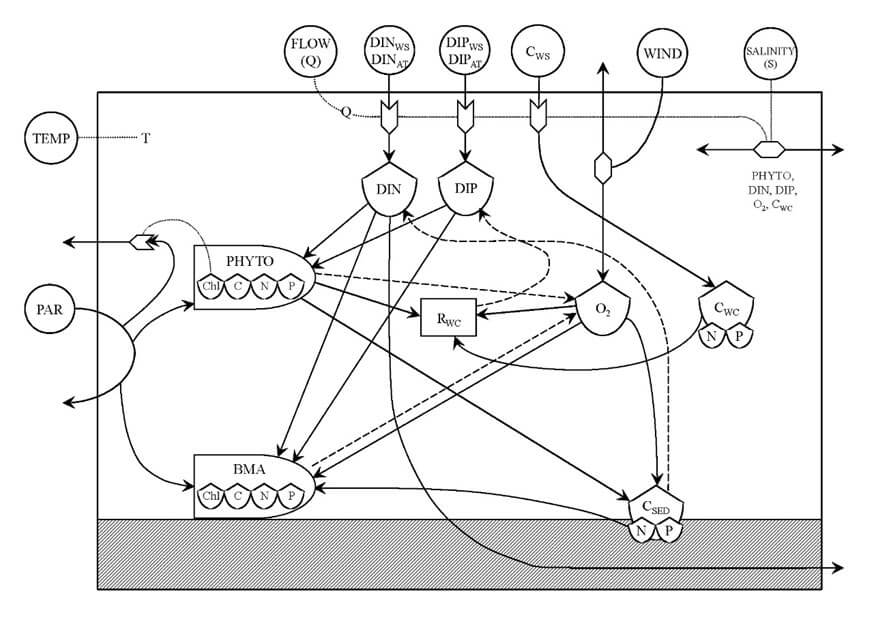Teaching, Researching and Protecting Estuarine Ecosystems with STELLA and isee NetSim
 Mark Brush
Mark Brush
The Virginia Institute of Marine Science’s (VIMS) legal mandate to deliver graduate-level education, conduct research and provide advisory services makes it unique among marine science
institutes. The models it builds and uses to teach, research, and protect estuarine ecosystems, areas where rivers meet the sea, are another distinguishing feature. “We are placing
models of coastal ecosystems directly into the hands of students, other researchers, and local stakeholders,” says Dr. Mark J. Brush, Associate Professor of Marine Science,
Department of Biological Sciences.
They can be new to modeling, they don’t have to download software, and they don’t have to know or learn a programming language
“There are a lot of marine science models built with complex programming languages like Fortran that run on expensive, high performance computers,” says Brush. “I wanted to create an
adaptable model that would reduce complexity. STELLA models can do much of what programmed models do and, with isee NetSim™, students and local decision-makers can explore their own
systems. They can be new to modeling, they don’t have to download software, and they don’t have to know or learn a programming language.”
Estuarine ecology and modeling
The models Brush, his students, and clients use to study estuarine ecology are focused on eutrophication, a process characterized by degraded water and habitat quality and typically
fueled by excessive nutrient loads. “Nutrients are essential up to a point, but too many nutrients are harmful to coastal waters,” says Brush. “Nutrient loads from human activity,
like sewage treatment plants and agricultural run-off, lead to algae blooms, a build-up of seaweed, low oxygen ‘dead zones’, and fish kills.”
They might test the effectiveness of reducing sewage treatment plant inputs or increasing the population of shellfish or amount of sea grass
“Our models start with nutrient loads – what and how much is going into the water – and predict what happens when levels of those nutrients are increased or reduced,” says Brush.
Students, researchers or local decision-makers can also determine the impact of water quality restoration methods. They might test the effectiveness of reducing sewage treatment
plant inputs or increasing the population of shellfish or amount of sea grass, both natural filters.
 Estuarine eutrophication model
Estuarine eutrophication model
Teaching estuarine ecology with STELLA
STELLA models are one of the primary teaching tools in Brush’s graduate modeling class. “Together, we’ll look at a published model, take it apart, and then rebuild it step by step,”
he says. “Assigned projects require students to build their own models which helps them understand Systems Thinking and how it can be applied to ecological systems.”
He models the exponential growth equation to both explain how it works and demonstrate how it applies to coastal ecosystems
Brush also uses models to teach essential concepts. For example, he models the exponential growth equation to both explain how it works and demonstrate how it applies to coastal ecosystems.
His annual undergraduate guest lecture also features estuarine modeling. “I give an overview of modeling and then, as a group, we review a NetSim model of a small Chesapeake Bay tributary.
Students break up into small groups and I challenge them to run the model to determine the best way to restore the system.”
Conducting research
Brush was an undergraduate at Cornell when he was first exposed to STELLA as a teaching assistant for an oceanography lab. At the University of Rhode Island, a professor who had a grant
to develop a model of nutrient-fueled eutrophication learned about Brush’s STELLA experience and brought him onto the project. Now Brush coaches his own graduate students through modeling
that supports their research.
Researchers can add submodels like eelgrass or shellfish that filter nutrients and simulate their impact
“Most of my graduate students are new to STELLA and most of them use it for their research,” says Brush. “They begin with my core model and adapt it for their own work.”
The core model includes the cycling of basic nutrients - nitrogen, phosphorous, carbon, oxygen and chlorophyll – through an estuarine ecosystem. It also includes levels
of phytoplankton in the water and benthic algae on the bottom. “The core model includes all the major components of any temperate estuary or coastal system and the key
features that respond to eutrophication,” says Brush. “Researchers can add submodels like eelgrass or shellfish that filter nutrients and simulate their impact.”
Providing advisory services
That same core model gives Brush and his students a starting place in providing service to local, state, and regional managers. A model of the Delmarva Peninsula coastal bays,
for example, adds water temperature and sea level rise to show local decision makers how a changing climate will influence eutrophication. “The Delmarva bays are shallow systems,
maybe 1 to 2 feet deep,” says Brush. “When the sea level rises, less sunlight reaches the bottom. That results in less benthic algae to filter nutrients so nutrient loads increase.”
The Narragansett Bay model allows decision-makers at the state level to determine acceptable nutrient loads for that ecosystem
Customizing the core model enables local stakeholders to consider their own issues with their own data. Existing models support West-Rhode River Estuary restoration, land use planning
on military bases as part of the Defense Coastal Estuarine Research Program (DCERP), oyster restoration in Harris Creek, Delmarva coastal bay management, and Narragansett Bay decision-making.
“The Narragansett Bay model allows decision-makers at the state level to determine acceptable nutrient loads for that ecosystem,” says Brush. “For example, they can use the model to reduce
sewage treatment plant loading by 30%. When they run the model, they’ll see if water quality meets their criteria. If it does, they know that 30% is a good target. Or they might want to
test other reduction levels.”
Improving the models
Models used by municipal, state, and federal decision-makers are considered Beta versions until the projects they support have been completed. “During projects, the models constantly
evolve as we work directly with stakeholders, get their feedback, and make them easy to use,” says Brush. “The DCERP model, for example, is part of a five year project. When we
finally hand it over we’ll have finished improving and calibrating it and users will have developed confidence to use it for their work.”
The ability to rapidly develop and serve new models online for direct use in the classroom or by stakeholders - that’s the advantage we have with STELLA and NetSim
Climate change has consequences for all coastal systems and is currently being built into the core model. “The model will allow users to ramp up water temperatures, precipitation, and
sea level rise using local forecast data,” says Brush. “They’ll see, for example, that increased water temperatures may require them to further reduce nutrient loads to keep water
quality in line with established criteria. And, they’ll be able to plan into the future.”
STELLA’s adaptability is also helping Brush and his team get involved in projects outside of their own mid-Atlantic neighborhood. “We’re about to start a project on the Gulf coast and are
continuing to expand our work along the East coast,” says Brush. With the core model in hand, Brush and his team are able to investigate, or enable local scientists and policy makers to
investigate, most temperate estuarine systems. “Most local communities and management agencies don’t have the time or money to develop and use a custom-programmed model,” says Brush.
“The ability to rapidly develop and serve new models online for direct use in the classroom or by stakeholders - that’s the advantage we have with STELLA and NetSim.”
Dr. Brush’s use of STELLA does not constitute an institutional endorsement of the model.